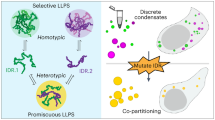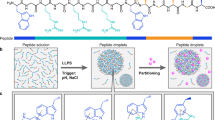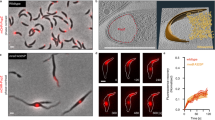Abstract
Phase separation of intrinsically disordered proteins (IDPs) is a remarkable feature of living cells to dynamically control intracellular partitioning. Despite the numerous new IDPs that have been identified, progress towards rational engineering in cells has been limited. To address this limitation, we systematically scanned the sequence space of native IDPs and designed artificial IDPs (A-IDPs) with different molecular weights and aromatic content, which exhibit variable condensate saturation concentrations and temperature cloud points in vitro and in cells. We created A-IDP puncta using these simple principles, which are capable of sequestering an enzyme and whose catalytic efficiency can be manipulated by the molecular weight of the A-IDP. These results provide a robust engineered platform for creating puncta with new, phase-separation-mediated control of biological function in living cells.

This is a preview of subscription content, access via your institution
Access options
Access Nature and 54 other Nature Portfolio journals
Get Nature+, our best-value online-access subscription
$29.99 / 30 days
cancel any time
Subscribe to this journal
Receive 12 print issues and online access
$259.00 per year
only $21.58 per issue
Buy this article
- Purchase on Springer Link
- Instant access to full article PDF
Prices may be subject to local taxes which are calculated during checkout







Similar content being viewed by others
Data availability
The data that support the findings of this study are available within this Article and its Supplementary Information. Material requests should be made to chilkoti@duke.edu.
References
Babu, M. M. The contribution of intrinsically disordered regions to protein function, cellular complexity, and human disease. Biochem. Soc. Trans. 44, 1185–1200 (2016).
Wright, P. E. & Dyson, H. J. Intrinsically disordered proteins in cellular signalling and regulation. Nat. Rev. Mol. Cell. Biol. 16, 18–29 (2015).
Uversky, V. N., Kuznetsova, I. M., Turoverov, K. K. & Zaslavsky, B. Intrinsically disordered proteins as crucial constituents of cellular aqueous two phase systems and coacervates. FEBS Lett. 589, 15–22 (2015).
Boeynaems, S. et al. Protein phase separation: a new phase in cell biology. Trends Cell. Biol. 28, 420–435 (2018).
Sickmeier, M. et al. DisProt: the database of disordered proteins. Nucleic Acids Res. 35, D786–D793 (2007).
Brangwynne, C. P., Tompa, P. & Pappu, R. V. Polymer physics of intracellular phase transitions. Nat. Phys. 11, 899–904 (2015).
Lin, Y., Currie, S. L. & Rosen, M. K. Intrinsically disordered sequences enable modulation of protein phase separation through distributed tyrosine motifs. J. Biol. Chem. 292, 19110–19120 (2017).
Pak, C. W. et al. Sequence determinants of intracellular phase separation by complex coacervation of a disordered protein. Mol. Cell. 63, 72–85 (2016).
Elbaum-Garfinkle, S. et al. The disordered P granule protein LAF-1 drives phase separation into droplets with tunable viscosity and dynamics. Proc. Natl Acad. Sci. USA 112, 7189–7194 (2015).
Lin, Y., Protter, D. S., Rosen, M. K. & Parker, R. Formation and maturation of phase-separated liquid droplets by RNA-binding proteins. Mol. Cell. 60, 208–219 (2015).
Nott, T. J. et al. Phase transition of a disordered nuage protein generates environmentally responsive membraneless organelles. Mol. Cell. 57, 936–947 (2015).
Molliex, A. et al. Phase separation by low complexity domains promotes stress granule assembly and drives pathological fibrillization. Cell 163, 123–133 (2015).
Franzmann, T. M. et al. Phase separation of a yeast prion protein promotes cellular fitness. Science 359, aao5654 (2018).
Best, R. B. Computational and theoretical advances in studies of intrinsically disordered proteins. Curr. Opin. Struct. Biol. 42, 147–154 (2017).
Dignon, G. L., Zheng, W., Best, R. B., Kim, Y. C. & Mittal, J. Relation between single-molecule properties and phase behavior of intrinsically disordered proteins. Proc. Natl Acad. Sci. USA 115, 9929–9934 (2018).
Dignon, G. L., Zheng, W., Kim, Y. C., Best, R. B. & Mittal, J. Sequence determinants of protein phase behavior from a coarse-grained model. PLoS Comput. Biol. 14, e1005941 (2018).
Mao, A. H., Crick, S. L., Vitalis, A., Chicoine, C. L. & Pappu, R. V. Net charge per residue modulates conformational ensembles of intrinsically disordered proteins. Proc. Natl Acad. Sci. USA 107, 8183–8188 (2010).
Wang, J. et al. A molecular grammar governing the driving forces for phase separation of prion-like RNA binding proteins. Cell 174, 688–699 (2018).
Dzuricky, M., Roberts, S. & Chilkoti, A. Convergence of artificial protein polymers and intrinsically disordered proteins. Biochemistry 57, 2405–2414 (2018).
Quiroz, F. G. & Chilkoti, A. Sequence heuristics to encode phase behaviour in intrinsically disordered protein polymers. Nat Mater. 14, 1164–1171 (2015).
Meyer, D. E. & Chilkoti, A. Quantification of the effects of chain length and concentration on the thermal behavior of elastin-like polypeptides. Biomacromolecules 5, 846–851 (2004).
Li, Z., Tyrpak, D. R., Lien, C.-L. & MacKay, J. A. Tunable assembly of protein-microdomains in living vertebrate embryos. Adv. Biosyst. 2, 1800112 (2018).
Shi, P., Lin, Y. A., Pastuszka, M., Cui, H. & Mackay, J. A. Triggered sorting and co-assembly of genetically engineered protein microdomains in the cytoplasm. Adv. Mater. 26, 449–454 (2014).
Huber, M. C. et al. Designer amphiphilic proteins as building blocks for the intracellular formation of organelle-like compartments. Nat. Mater. 14, 125–132 (2015).
Pastuszka, M. K. et al. A tunable and reversible platform for the intracellular formation of genetically engineered protein microdomains. Biomacromolecules 13, 3439–3444 (2012).
Qamar, S. et al. FUS phase separation is modulated by a molecular chaperone and methylation of arginine cation–π interactions. Cell 173, 720–734 (2018).
Shin, Y. & Brangwynne, C. P. Liquid phase condensation in cell physiology and disease. Science 357, eaaf4382 (2017).
Lin, Y. H., Forman-Kay, J. D. & Chan, H. S. Sequence-specific polyampholyte phase separation in membraneless organelles. Phys. Rev. Lett. 117, 178101 (2016).
Li, L., Luo, T. & Kiick, K. L. Temperature-triggered phase separation of a hydrophilic resilin-like polypeptide. Macromol. Rapid Commun. 36, 90–95 (2015).
Balu, R. et al. An16-resilin: an advanced multi-stimuli-responsive resilin-mimetic protein polymer. Acta Biomater. 10, 4768–4777 (2014).
Uversky, V. N. & Dunker, A. K. Understanding protein non-folding. Biochim. Biophys. Acta 1804, 1231–1264 (2010).
Theillet, F. X. et al. The alphabet of intrinsic disorder: I. Act like a Pro: on the abundance and roles of proline residues in intrinsically disordered proteins. Intrinsically Disord. Proteins 1, e24360 (2013).
Kyte, J. & Doolittle, R. F. A simple method for displaying the hydropathic character of a protein. J. Mol. Biol. 157, 105–132 (1982).
Wimley, W. C. & White, S. H. Experimentally determined hydrophobicity scale for proteins at membrane interfaces. Nat. Struct. Mol. Biol. 3, 842–848 (1996).
Das, R. K. & Pappu, R. V. Conformations of intrinsically disordered proteins are influenced by linear sequence distributions of oppositely charged residues. Proc. Natl Acad. Sci. USA 110, 13392–13397 (2013).
Lin, Y. H. & Chan, H. S. Phase separation and single-chain compactness of charged disordered proteins are strongly correlated. Biophys. J. 112, 2043–2046 (2017).
Urry, D. W. et al. Hydrophobicity scale for proteins based on inverse temperature transitions. Biopolymers 32, 1243–1250 (1992).
Van Roey, K. et al. Short linear motifs: ubiquitous and functionally diverse protein interaction modules directing cell regulation. Chem. Rev. 114, 6733–6778 (2014).
Martin, E. W. et al. Valence and patterning of aromatic residues determine the phase behavior of prion-like domains. Science 367, 694–699 (2020).
MacEwan, S. R. et al. Phase behavior and self-assembly of perfectly sequence-defined and monodisperse multiblock copolypeptides. Biomacromolecules 18, 599–609 (2017).
Muiznieks, L. D. & Keeley, F. W. Proline periodicity modulates the self-assembly properties of elastin-like polypeptides. J. Biol. Chem. 285, 39779–39789 (2010).
Bochicchio, B., Pepe, A. & Tamburro, A. M. Investigating by CD the molecular mechanism of elasticity of elastomeric proteins. Chirality 20, 985–994 (2008).
Rubinstein, M. & Colby, R. H. Polymer Physics (Oxford Univ. Press, 2003).
Bracha, D. et al. Mapping local and global liquid phase behavior in living cells using photo-oligomerizable seeds. Cell 175, 1467–1480 (2018).
Banani, S. F., Lee, H. O., Hyman, A. A. & Rosen, M. K. Biomolecular condensates: organizers of cellular biochemistry. Nat. Rev. Mol. Cell Biol. 18, 285–298 (2017).
Strulson, C. A., Molden, R. C., Keating, C. D. & Bevilacqua, P. C. RNA catalysis through compartmentalization. Nat. Chem. 4, 941–946 (2012).
Banjade, S. & Rosen, M. K. Phase transitions of multivalent proteins can promote clustering of membrane receptors. eLife https://doi.org/10.7554/eLife.04123 (2014).
Li, P. et al. Phase transitions in the assembly of multivalent signalling proteins. Nature 483, 336–340 (2012).
Hofmann, J. & Sernetz, M. A kinetic study on the enzymatic hydrolysis of fluoresceindiacetate and fluorescein-di-β-d-galactopyranoside. Analytical biochemistry 131, 180–186 (1983).
Lewis, P., Nwoguh, C., Barer, M., Harwood, C. & Errington, J. Use of digitized video microscopy with a fluorogenic enzyme substrate to demonstrate cell‐and compartment‐specific gene expression in Salmonella enteritidis and Bacillus subtilis. Molecular microbiology 13, 655–662 (1994).
Broome, A. M., Bhavsar, N., Ramamurthy, G., Newton, G. & Basilion, J. P. Expanding the utility of β-galactosidase complementation: piece by piece. Mol. Pharm. 7, 60–74 (2010).
Moosmann, P. & Rusconi, S. Alpha complementation of LacZ in mammalian cells. Nucleic Acids Res. 24, 1171–1172 (1996).
Manders, E., Stap, J., Brakenhoff, G., Van Driel, R. & Aten, J. Dynamics of three-dimensional replication patterns during the S-phase, analysed by double labelling of DNA and confocal microscopy. J. Cell Sci. 103, 857–862 (1992).
Duan, X., Chen, J. & Wu, J. Improving the thermostability and catalytic efficiency of Bacillus deramificans pullulanase by site-directed mutagenesis. Appl. Environ. Microbiol. 79, 4072–4077 (2013).
Goldsmith, M. & Tawfik, D. S. Enzyme engineering: reaching the maximal catalytic efficiency peak. Curr. Opin. Struct. Biol. 47, 140–150 (2017).
Nayeem, A. et al. Engineering enzymes for improved catalytic efficiency: a computational study of site mutagenesis in epothilone-B hydroxylase. Protein Eng. Des. Sel. 22, 257–266 (2009).
Brady, J. P. et al. Structural and hydrodynamic properties of an intrinsically disordered region of a germ cell-specific protein on phase separation. Proc. Natl Acad. Sci. USA 114, E8194–E8203 (2017).
Yoshizawa, T. et al. Nuclear import receptor inhibits phase separation of FUS through binding to multiple sites. Cell 173, e622 (2018).
Holehouse, A. S. & Pappu, R. V. Functional implications of intracellular phase transitions. Biochemistry 57, 2415–2423 (2018).
Peng, K., Radivojac, P., Vucetic, S., Dunker, A. K. & Obradovic, Z. Length-dependent prediction of protein intrinsic disorder. BMC Bioinformatics 7, 208 (2006).
Tang, N. C. & Chilkoti, A. Combinatorial codon scrambling enables scalable gene synthesis and amplification of repetitive proteins. Nat. Mater. 15, 419–424 (2016).
McDaniel, J. R., Mackay, J. A., Quiroz, F. G. & Chilkoti, A. Recursive directional ligation by plasmid reconstruction allows rapid and seamless cloning of oligomeric genes. Biomacromolecules 11, 944–952 (2010).
Simon, J. R., Carroll, N. J., Rubinstein, M., Chilkoti, A. & Lopez, G. P. Programming molecular self-assembly of intrinsically disordered proteins containing sequences of low complexity. Nat. Chem. 9, 509–515 (2017).
Hassouneh, W., Zhulina, E. B., Chilkoti, A. & Rubinstein, M. Elastin-like polypeptide diblock copolymers self-assemble into weak micelles. Macromolecules 48, 4183–4195 (2015).
Fluegel, S., Fischer, K., McDaniel, J. R., Chilkoti, A. & Schmidt, M. Chain stiffness of elastin-like polypeptides. Biomacromolecules 11, 3216–3218 (2010).
Acknowledgements
A.C. acknowledges support from the National Institutes of Health (NIH) through an MIRA grant R35GM127042 and from the National Science Foundation (NSF) through a DMREF grant DMR-17-29671. P.S.C acknowledges support from the National Science Foundation through CHE-1709735.
Author information
Authors and Affiliations
Contributions
M.D. and A.C. designed the experiments and wrote the manuscript. M.D. performed each measurement and analysed the data with the exception of microfluidic temperature-gradient experiments that were performed and analysed by B.A.R. A.S. assisted with UCST cloud-point determination and non-repetitive A-IDP design. P.S.C. assisted in writing the manuscript. All authors discussed the result and commented on the manuscript.
Corresponding author
Ethics declarations
Competing interests
The authors declare no competing interests.
Additional information
Publisher’s note Springer Nature remains neutral with regard to jurisdictional claims in published maps and institutional affiliations.
Supplementary information
Supplementary Information
Extended Materials and Methods, Supplementary Figs. 1–24 and Tables 1–6.
Rights and permissions
About this article
Cite this article
Dzuricky, M., Rogers, B.A., Shahid, A. et al. De novo engineering of intracellular condensates using artificial disordered proteins. Nat. Chem. 12, 814–825 (2020). https://doi.org/10.1038/s41557-020-0511-7
Received:
Accepted:
Published:
Issue Date:
DOI: https://doi.org/10.1038/s41557-020-0511-7
This article is cited by
-
Local environment in biomolecular condensates modulates enzymatic activity across length scales
Nature Communications (2024)
-
High-throughput and proteome-wide discovery of endogenous biomolecular condensates
Nature Chemistry (2024)
-
Assembling membraneless organelles from de novo designed proteins
Nature Chemistry (2024)
-
Expanding the molecular language of protein liquid–liquid phase separation
Nature Chemistry (2024)
-
The molecular basis for cellular function of intrinsically disordered protein regions
Nature Reviews Molecular Cell Biology (2024)



